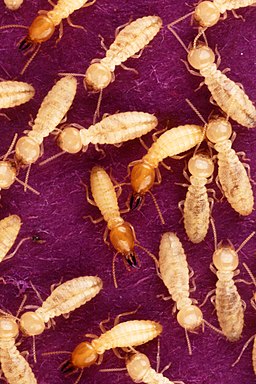[vc_row][vc_column][vc_column_text]
The Formosan Termites

HOW TO IDENTIFY FORMOSAN TERMITES
Appearance
Formosan termites have a yellowish-brown colored body which lets them merge inside the wood they are attacking. It’s difficult to notice them at first sight.
They have a slender body with an egg-shaped head. They usually are ½ inch long, whereas their swarmers are shorter in size and are just 14-15 mm long. Their translucent wings are equal to their body size and are covered with hairs, whereas their mandibles lack teeth.
Behavior
Formosan Termites prefer to live in warm and humid climatic conditions. In their bodies, they even construct water-retention structures so they don’t have to go back to the ground.
They have large colonies, and each colony can produce up to 1000 eggs daily. It helps them to quickly expand over other wooden structures. They feed upon anything that’s comprised of wood fiber, like plants, trees, building structures, etc.
Swarmers are attracted toward light. Therefore, they can be seen outside the wood, flying around.
Signs
The signs of a Formosan termite colony are swarmers flying around your wooden structure and discarded wings near lights, doors and windows.
Though they are subterranean termites, they are also known for constructing aerial nests in the wooden structures they infest. When they infest a building or structure, soil shelter tubes can be seen above ground and on walls.
These are about 0.25-0.5-inch-wide tubes, which are used to connect soil tubes with the house. These tubes are filled with worker and soldier termites and can be seen after breaking them. Presence of these tubes indicates a serious termite problem.[/vc_column_text][/vc_column][/vc_row][vc_row][vc_column][vc_column_text]
HOW DO YOU GET FORMOSAN TERMITES

Scott Bauer, USDA Agricultural Research Service, Bugwood.org
Just like every other termite, the reasons for their entry is wood and water. Swarmers flying around can land on your door or window and make it its home, whereas an infested neighborhood can also invite these dangerous pests to your house.
Moreover, if you have accumulated water, like rainwater, in any area of your home, or trees outside near your door or touching your window, Formosan termites can find a way to infest your home. Second-hand infested stuff can also be a reason for their swarming.
HOW TO GET RID OF FORMOSAN TERMITES
Once Formosan termites infest your building or wooden structure, it’s impossible to get rid of them because these aggressive termites reproduce at an unbelievably high speed and spread throughout the structure.
Their extensive foraging and huge colonies damage an entire structure within months. By the time you notice their presence, the damage has already been done.
Therefore, prevent your homes and buildings from these dangerous termites and carry out these preventive measures:
- Eliminate any earth-to-wood contact in your home and building, like fences, scrap wood, stairs, etc. This will eliminate their pathway towards your home.
- Fill the cracks and holes in roofs, walls, and a house’s foundation.
- Take great care of sewerage and water drainage, especially near a house’s foundation. Don’t let any sort of water accumulate around your house and try to reduce the humidity level as much as you can.
- Treat your house, garden, and buildings soil with chemicals. Build a chemical barrier between them and your house. This will keep them away from your building.
[/vc_column_text][/vc_column][/vc_row][vc_row][vc_column][vc_column_text]
Formosan Termite Facts
- A single Formosan termite colony has millions of members
- A single colony can eat away 400g of wood in one day
- These are economically distressing termites. In the US annually, $1 billion is spent on preventive and remedial measures against Formosan termites.
[/vc_column_text][/vc_column][/vc_row][vc_row][vc_column][vc_separator][/vc_column][/vc_row][vc_row][vc_column][vc_column_text]
Termite Articles
[catlist name=”termites”][/vc_column_text][/vc_column][/vc_row][vc_row][vc_column][vc_empty_space][/vc_column][/vc_row]
